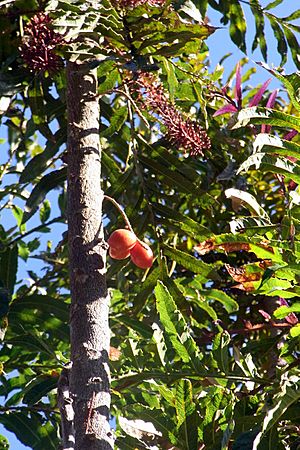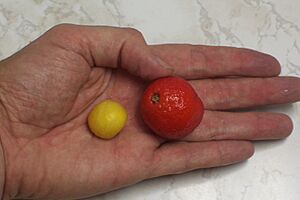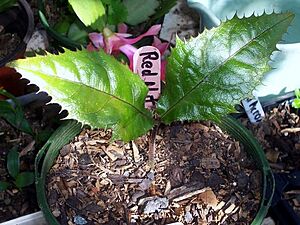Red bopple nut facts for kids
Quick facts for kids Red bopple nut |
|
|---|---|
 |
|
| Fruiting tree | |
| Conservation status | |
| Scientific classification | |
| Genus: |
Hicksbeachia
|
| Species: |
pinnatifolia
|
The Hicksbeachia pinnatifolia is a small tree that belongs to the Proteaceae plant family. It's quite rare and grows naturally in the warm, wet rainforests of New South Wales and Queensland in Australia. People call it by many fun names like red bopple nut, monkey nut, red nut, beef nut, rose nut, and ivory silky oak. This tree produces bright red, juicy fruits in spring and summer, and inside these fruits are seeds that you can eat!
Contents
About This Tree
The Hicksbeachia pinnatifolia was first officially described in 1883 by a German-Australian scientist named Ferdinand von Mueller. He found it near the Tweed River in northern New South Wales.
What it Looks Like
This tree can grow up to about 10 metres (33 feet) tall. Its trunk can be up to 20 centimetres (8 inches) wide. Sometimes, new stems can grow from its base, and it can even sprout new plants after being cut down.
Its leaves are very large and made up of many smaller leaflets, like a feather. A whole leaf can be from 40 to 100 centimetres (16 to 39 inches) long. Each leaflet is usually 6 to 25 centimetres (2 to 10 inches) long and 2 to 6 centimetres (1 to 2 inches) wide. The edges of the leaves have tiny teeth. When new leaves grow, they are covered in fine, rusty-coloured hairs.
Flowers and Fruit
In winter and spring (around August to October), the tree grows long flower spikes that hang down. These spikes can be 14 to 50 centimetres (6 to 20 inches) long and are purple, brown, and cream coloured. They have a strong, sweet smell, though some people find it a bit too strong!
After the flowers, in spring and summer, the tree produces its special red fruits. These fruits are oval-shaped, about 3 to 5 centimetres (1 to 2 inches) long and 2 to 2.8 centimetres (1 inch) wide. Inside each fruit is a black seed. The fruit stays on the tree and doesn't usually fall off on its own.

Where it Grows
You can find Hicksbeachia pinnatifolia in subtropical rainforests. It grows from Tamborine Mountain in southeastern Queensland all the way down to the Nambucca Valley on the mid-north coast of New South Wales. It usually grows as part of the lower layer of plants in the forest, under the taller trees.
Uses and Growing Your Own
The seed inside the red fruit is safe to eat! While it's not as famous or widely grown as its cousin, the macadamia, it's still a tasty treat. This tree isn't grown on big farms, but some people like to plant it in their gardens as an ornamental tree because it looks so nice.
It can be a bit tricky to get the tree to grow well in a garden at first. If you plant fresh seeds, they usually sprout easily. However, many young plants can sometimes get sick from fungi. To help them, some experts suggest adding leaf litter from under a healthy Hicksbeachia tree. This litter can contain helpful tiny organisms that protect the young plants.
See also
 In Spanish: Hicksbeachia pinnatifolia para niños
In Spanish: Hicksbeachia pinnatifolia para niños



